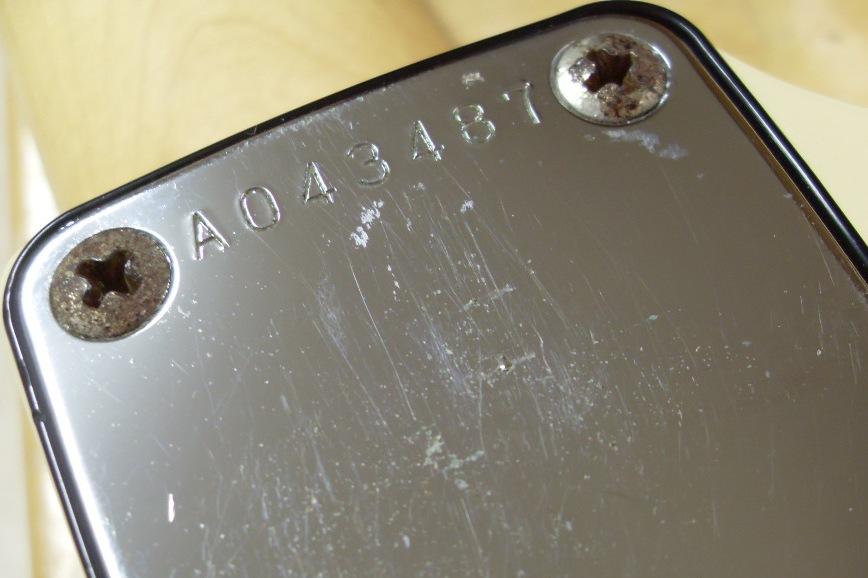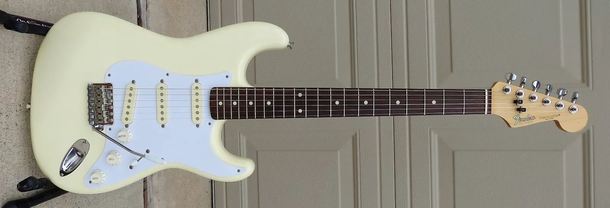The Japanese Standard Stratocasters, such as the reissues, could be divided into models intended for export to the Western market and models intended for the Japanese one.
Unlike the reissues, the logo was not the Spaghetti, but silverish CBS style.
Unlike the reissues, the logo was not the Spaghetti, but silverish CBS style.
STANDARD STRATOCASTERS MADE IN JAPAN: DOMESTIC MODELS
The first Japanese Standard Stratocaster was the ST83-80, which dates back to 1983 and was marketed for only one year. It was almost identical to the Standard Stratocaster made in the USA in the same year, nicknamed “2-Knob Strat” because instead of the second tone control there was the jack socket, but it differed from it because it had 22 frets. Otherwise, it was identical: in fact, even the Japanese version had the BiFlex truss rod, the Freeflyte tremolo, an almost flat keyboard (12”), micro-tilt and American flat-pole pickups.
This guitar was followed by many other Standard models, sometimes made with leftovers from other productions, and almost all had basswood body, polyester finish and ceramic pickups. Strangely, the serial number used on the “Standard” Stratocasters made since 1997 and intended for the Japanese market only, such as the ST-38, all characterized by a silverish CBS-style logo, had a “MADE IN JAPAN” decal on the headstock, although they were built during the “Crafted in Japan” period!
This guitar was followed by many other Standard models, sometimes made with leftovers from other productions, and almost all had basswood body, polyester finish and ceramic pickups. Strangely, the serial number used on the “Standard” Stratocasters made since 1997 and intended for the Japanese market only, such as the ST-38, all characterized by a silverish CBS-style logo, had a “MADE IN JAPAN” decal on the headstock, although they were built during the “Crafted in Japan” period!
STANDARD STRATOCASTERS MADE IN JAPAN: EXPORT MODELS
Export Japanese Standard Stratocasters were instruments with a basswood body, often very different from each other, that could be either Fender branded or Squier branded. They were all available in the fretted maple neck model and in the rosewood fretboard one.
Two Squier Standard Stratocaster models had been made:
The 27-8800/2, produced between 1987 and 1988, with a more aggressive appearance, had a Fender Tremolo System I bridge associated with a string clamp.
The 27-4600/2, fabricated between the end of 1984 and 1988, was definitely more conventional as it was equipped with the classic vintage-style tremolo. Sometimes incorrectly referred to as Squier '50s Stratocaster, if fretted maple neck, or Squier '60s Stratocaster, if equipped with a rosewood fretboard, it had a basswood body and was suitable for those who loved the Vintage series, but did not have the right financial resources.
In 1988, when the Squier brand moved to Korea, it was promoted to Fender: in fact, the fourth model of Fender Standard Stratocaster, in production between the end of 1988 and 1990, was identical, apart from the decal, to this Squier Standard, so that also the model number remained the same.
The 27-8800/2, produced between 1987 and 1988, with a more aggressive appearance, had a Fender Tremolo System I bridge associated with a string clamp.
The 27-4600/2, fabricated between the end of 1984 and 1988, was definitely more conventional as it was equipped with the classic vintage-style tremolo. Sometimes incorrectly referred to as Squier '50s Stratocaster, if fretted maple neck, or Squier '60s Stratocaster, if equipped with a rosewood fretboard, it had a basswood body and was suitable for those who loved the Vintage series, but did not have the right financial resources.
In 1988, when the Squier brand moved to Korea, it was promoted to Fender: in fact, the fourth model of Fender Standard Stratocaster, in production between the end of 1988 and 1990, was identical, apart from the decal, to this Squier Standard, so that also the model number remained the same.
Squier Standard Stratcaster, model 27-4600, "A" Series
Squier Standard Stratocaster, model 27-8800 (axesboldaslovejimidavis)
Fender Standard Stratocasters differed from Japanese reissues for the clear '70s style logo (on small headstock) and for the flat poles pickups.
The first model (27-4300/2), made between 1985 and 1987, was sometimes grouped with the Contemporary due to its aggressive appearance: it had twenty-two frets and was equipped with a Fender System I bridge and related string clamp. Its saddle heights were not individually adjustable, but it was nevertheless possible to regulate their intonation, and the bridge height could be modified through the two screws by which it was fixed to the guitar and that acted like a pivot. “System I with a conventional headstock locking system behind the nut is a 3-vise system that uses an allen wrench. The fine tuning, floating bridge ha two knife-edge pivots, height adjustable pivot posts, roller saddles and a snap-in adjustable tremolo arm.”
The second model (28-4300/2) appeared only in 1987 and differed from the previous one for the presence of the Kahler Traditional 2520 Fulcrum Tremolo. This was a fulcrum based tremolo designed as an alternative to the stock Fender tremolo system. “Kahler Traditional Series fulcrum tremolos adjust to you and your style (not the other way around). Our new bridge saddles allow you to set intonation, and string spacing all independently. Now you don't lose control of feel and sound. Our new roller saddle lock solidly o the tremolo mounting plate to insure solid harmonic transfer for superb tone and sustain. You can also lock out any roller movement you prefer. Separate screw adjustment allows you to choose easy or resistant tremolo arm rotation. [...] Our "pro" traditional models include no wrench string lock as standard equipment.”
Between 1988 and 1989 a third model (25-4300/2) came out, with a Kahler Spyder Tremolo and locking nut. “The Spyder is one of our most innovative bridges. This Double Locking fulcrum style bridge offers maximum sustain with steel witness points and Kahler's own patented knife bolt hinging system. Wider stud spacing allows for easy retrofit to many guitars. The Spyder is Auto-Latch ready, and other options include finger-locking and non-locking saddle sets. The Spyder is durable and economical yet flexible enough to meet every players needs.”
The reason is unclear, but this model is almost always without the “MADE IN JAPAN” decal, even if its origin is evident. Guitars that exhibit that decal are extremely rare and perhaps these are transition models.
The reason is unclear, but this model is almost always without the “MADE IN JAPAN” decal, even if its origin is evident. Guitars that exhibit that decal are extremely rare and perhaps these are transition models.
Common features of these first three Standard Stratocasters were the flat fretboard and the presence of smaller dots compared to the American ones or those of the first Japanese guitars.
The fourth and last Fender Standard Stratocaster made in Japan (27-4600/2) was made between the end of 1988 and 1990, and looked much more traditional. It had two string trees, twenty-one frets, 7.25" radius, truss rod adjustment at the heel of the neck, one layer pickguard and vintage style bridge. It was fundamentally different from the first, and identical apart from the decal, to the Squier Standard Stratocaster made in Japan. In fact, with the transfer of the Squier brand to Korean factories, Fender continued to produce the Squier Standard Stratocaster made in Japan with the Fender brand rather than the Squier brand.
In 1991, after the opening of Ensenada, it left the scene and was replaced by the Standard Stratocaster made in Mexico.
In 1991, after the opening of Ensenada, it left the scene and was replaced by the Standard Stratocaster made in Mexico.
Antonio Calvosa


















